Ethics and Sustainability: Corruption's Effects on Government Spending
VerifiedAdded on 2023/06/05
|11
|2392
|286
Report
AI Summary
This report investigates the pervasive issues of corruption in Australia, highlighting the vulnerabilities within national governance that facilitate its spread. It examines the detrimental effects of corruption on government spending, particularly in defense and public services, and its subsequent impact on economic growth and public satisfaction. The report analyzes how corruption leads to inefficient allocation of resources, increased costs for citizens, and ultimately, a decline in public trust and economic stability. By integrating corruption into an extended economic model, the study demonstrates how different components of government expenditure are affected, depending on their relative shares and elasticities. The report concludes with recommendations for the government to enhance transparency, engage with the public, enforce stricter laws against bribery, and utilize non-governmental organizations and digital services to monitor government activities and curb corruption, emphasizing that even small acts of bribery contribute to significant economic decline.
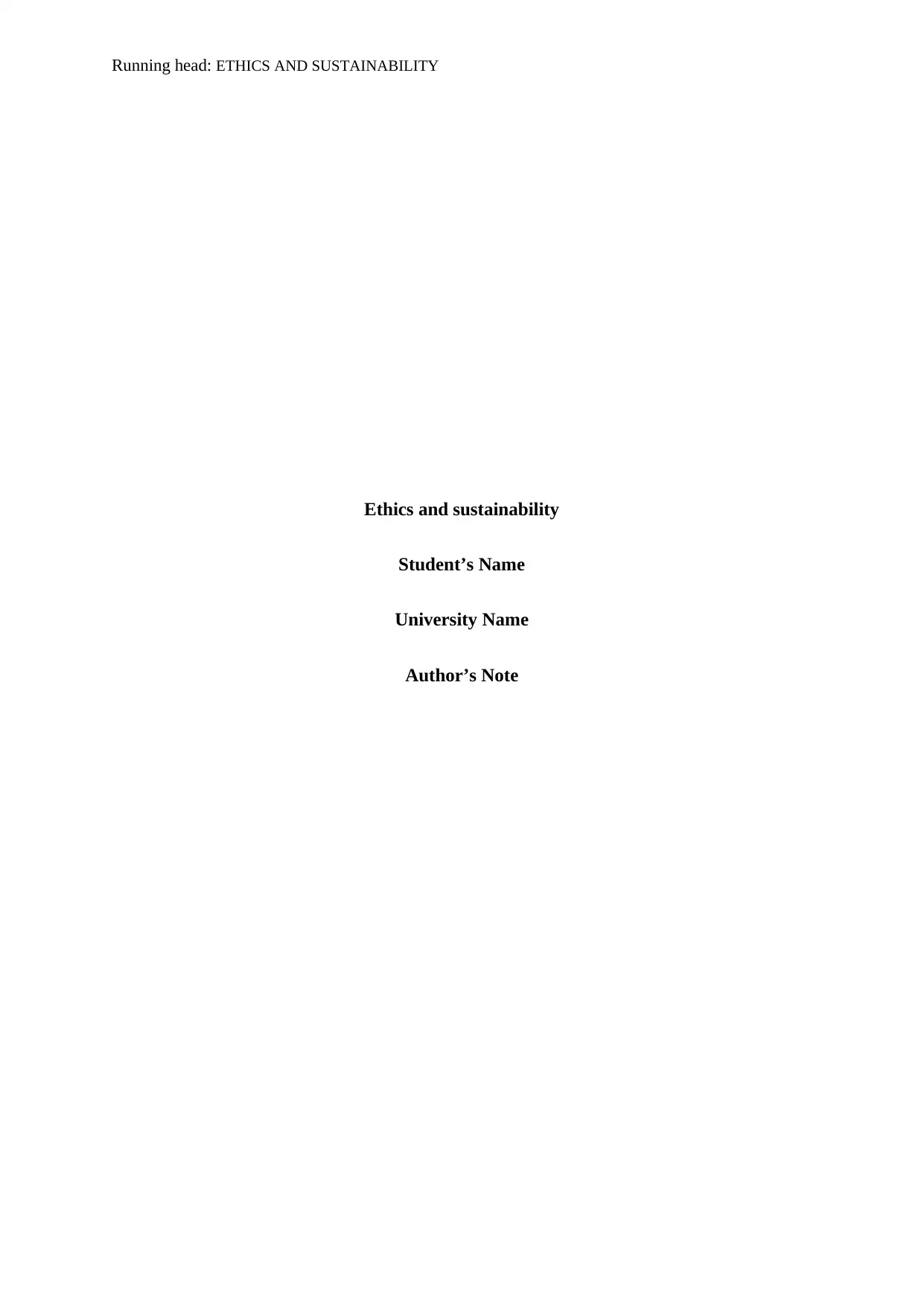
Running head: ETHICS AND SUSTAINABILITY
Ethics and sustainability
Student’s Name
University Name
Author’s Note
Ethics and sustainability
Student’s Name
University Name
Author’s Note
Paraphrase This Document
Need a fresh take? Get an instant paraphrase of this document with our AI Paraphraser
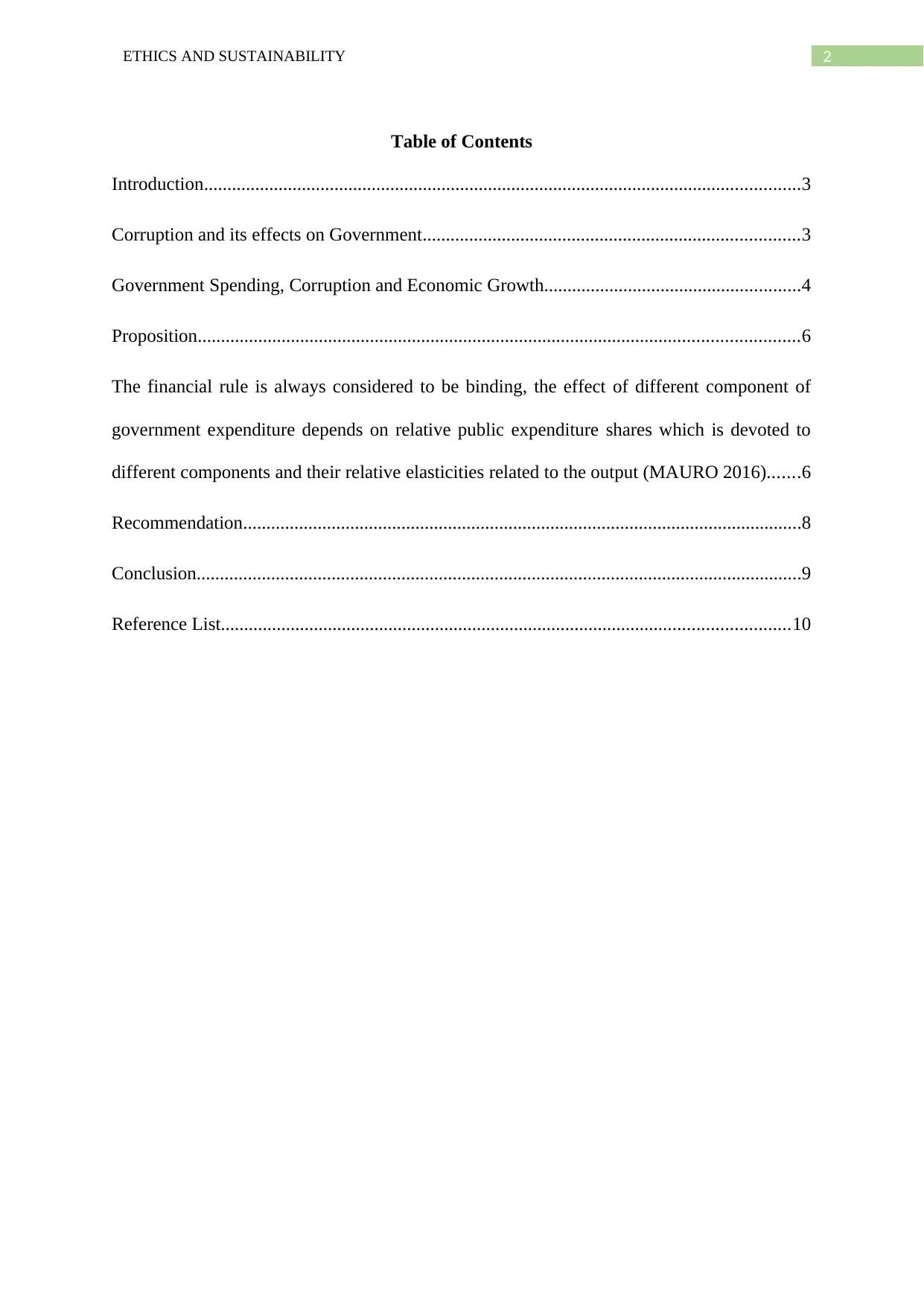
2ETHICS AND SUSTAINABILITY
Table of Contents
Introduction................................................................................................................................3
Corruption and its effects on Government.................................................................................3
Government Spending, Corruption and Economic Growth.......................................................4
Proposition.................................................................................................................................6
The financial rule is always considered to be binding, the effect of different component of
government expenditure depends on relative public expenditure shares which is devoted to
different components and their relative elasticities related to the output (MAURO 2016).......6
Recommendation........................................................................................................................8
Conclusion..................................................................................................................................9
Reference List..........................................................................................................................10
Table of Contents
Introduction................................................................................................................................3
Corruption and its effects on Government.................................................................................3
Government Spending, Corruption and Economic Growth.......................................................4
Proposition.................................................................................................................................6
The financial rule is always considered to be binding, the effect of different component of
government expenditure depends on relative public expenditure shares which is devoted to
different components and their relative elasticities related to the output (MAURO 2016).......6
Recommendation........................................................................................................................8
Conclusion..................................................................................................................................9
Reference List..........................................................................................................................10
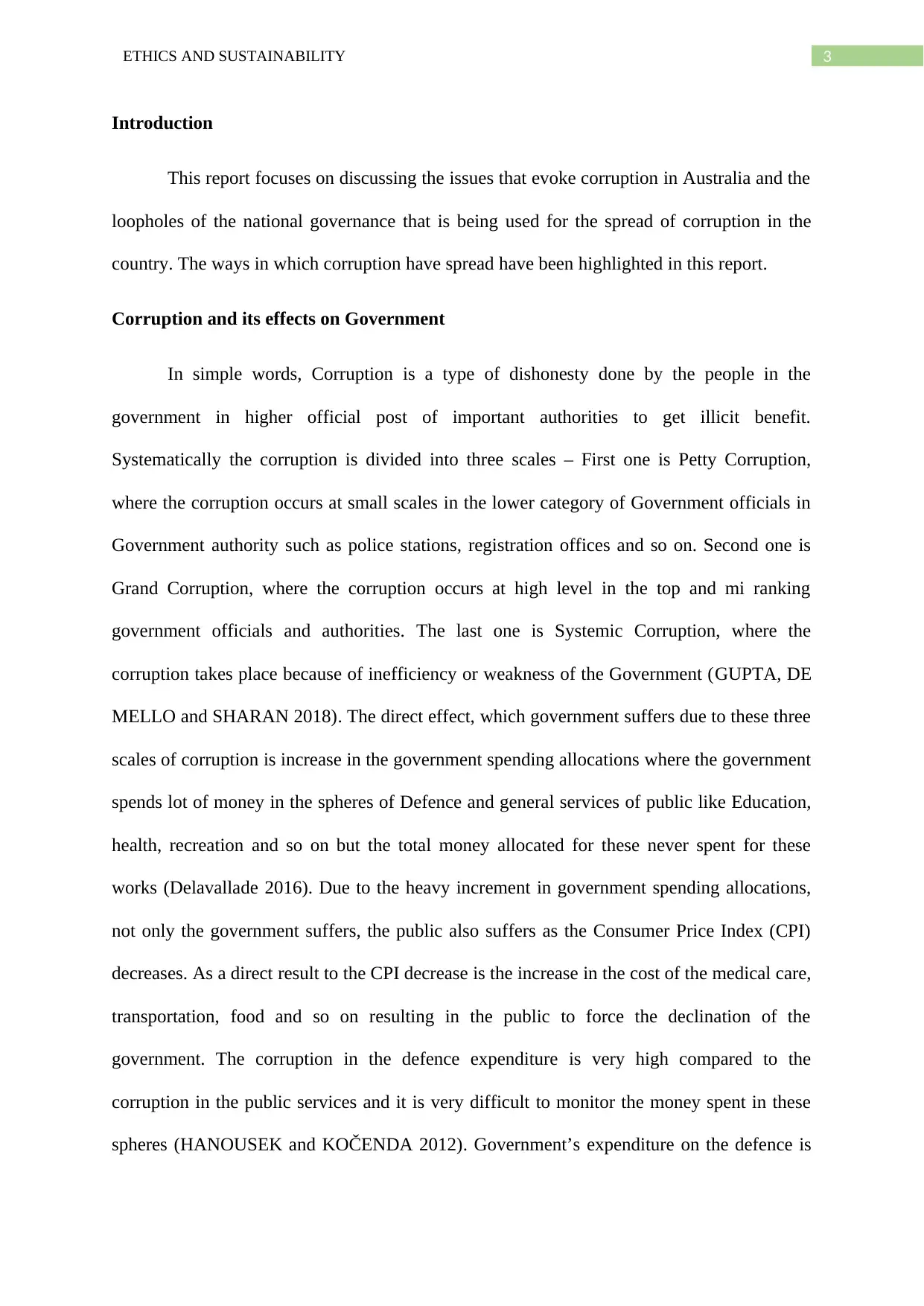
3ETHICS AND SUSTAINABILITY
Introduction
This report focuses on discussing the issues that evoke corruption in Australia and the
loopholes of the national governance that is being used for the spread of corruption in the
country. The ways in which corruption have spread have been highlighted in this report.
Corruption and its effects on Government
In simple words, Corruption is a type of dishonesty done by the people in the
government in higher official post of important authorities to get illicit benefit.
Systematically the corruption is divided into three scales – First one is Petty Corruption,
where the corruption occurs at small scales in the lower category of Government officials in
Government authority such as police stations, registration offices and so on. Second one is
Grand Corruption, where the corruption occurs at high level in the top and mi ranking
government officials and authorities. The last one is Systemic Corruption, where the
corruption takes place because of inefficiency or weakness of the Government (GUPTA, DE
MELLO and SHARAN 2018). The direct effect, which government suffers due to these three
scales of corruption is increase in the government spending allocations where the government
spends lot of money in the spheres of Defence and general services of public like Education,
health, recreation and so on but the total money allocated for these never spent for these
works (Delavallade 2016). Due to the heavy increment in government spending allocations,
not only the government suffers, the public also suffers as the Consumer Price Index (CPI)
decreases. As a direct result to the CPI decrease is the increase in the cost of the medical care,
transportation, food and so on resulting in the public to force the declination of the
government. The corruption in the defence expenditure is very high compared to the
corruption in the public services and it is very difficult to monitor the money spent in these
spheres (HANOUSEK and KOČENDA 2012). Government’s expenditure on the defence is
Introduction
This report focuses on discussing the issues that evoke corruption in Australia and the
loopholes of the national governance that is being used for the spread of corruption in the
country. The ways in which corruption have spread have been highlighted in this report.
Corruption and its effects on Government
In simple words, Corruption is a type of dishonesty done by the people in the
government in higher official post of important authorities to get illicit benefit.
Systematically the corruption is divided into three scales – First one is Petty Corruption,
where the corruption occurs at small scales in the lower category of Government officials in
Government authority such as police stations, registration offices and so on. Second one is
Grand Corruption, where the corruption occurs at high level in the top and mi ranking
government officials and authorities. The last one is Systemic Corruption, where the
corruption takes place because of inefficiency or weakness of the Government (GUPTA, DE
MELLO and SHARAN 2018). The direct effect, which government suffers due to these three
scales of corruption is increase in the government spending allocations where the government
spends lot of money in the spheres of Defence and general services of public like Education,
health, recreation and so on but the total money allocated for these never spent for these
works (Delavallade 2016). Due to the heavy increment in government spending allocations,
not only the government suffers, the public also suffers as the Consumer Price Index (CPI)
decreases. As a direct result to the CPI decrease is the increase in the cost of the medical care,
transportation, food and so on resulting in the public to force the declination of the
government. The corruption in the defence expenditure is very high compared to the
corruption in the public services and it is very difficult to monitor the money spent in these
spheres (HANOUSEK and KOČENDA 2012). Government’s expenditure on the defence is
⊘ This is a preview!⊘
Do you want full access?
Subscribe today to unlock all pages.

Trusted by 1+ million students worldwide
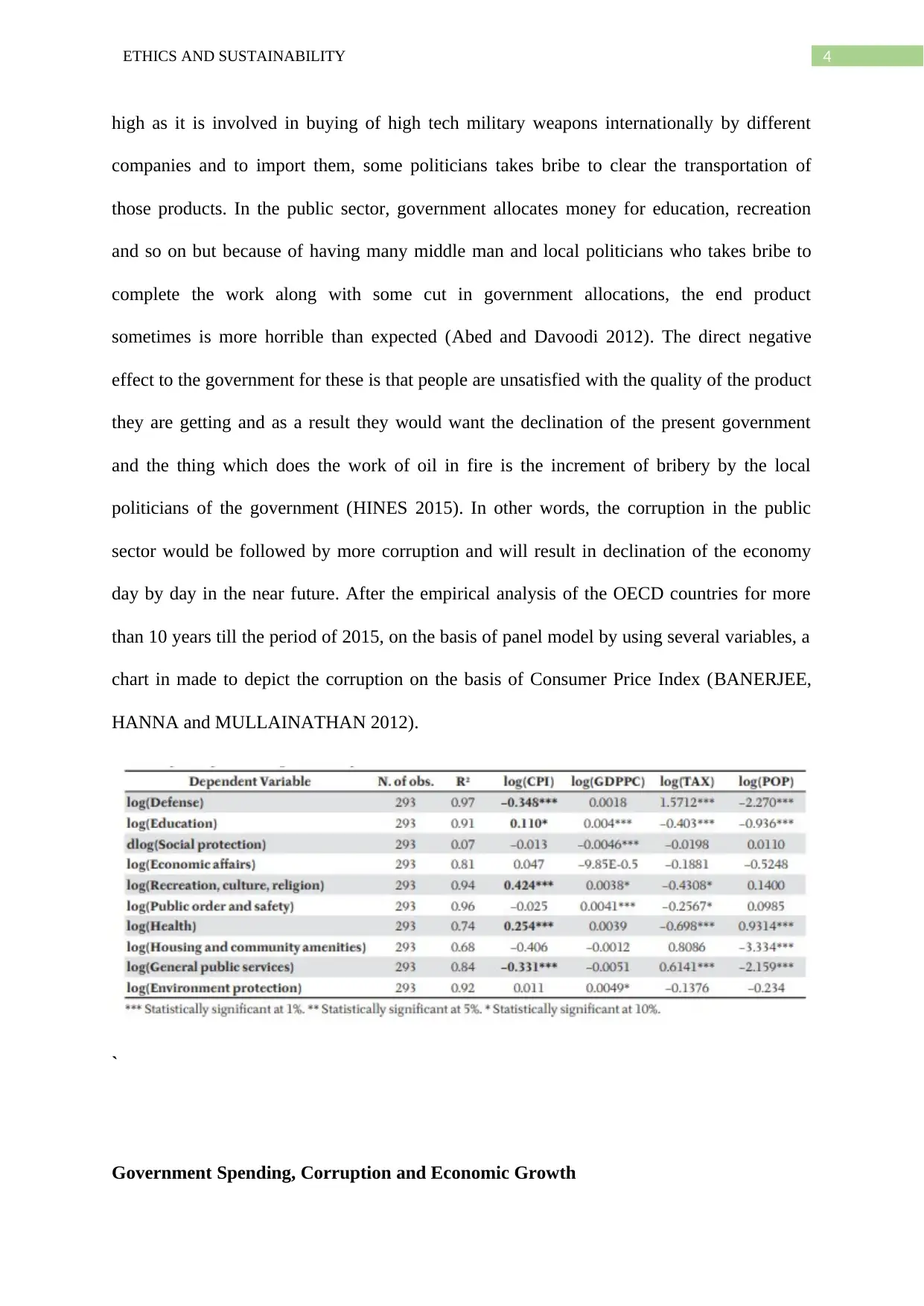
4ETHICS AND SUSTAINABILITY
high as it is involved in buying of high tech military weapons internationally by different
companies and to import them, some politicians takes bribe to clear the transportation of
those products. In the public sector, government allocates money for education, recreation
and so on but because of having many middle man and local politicians who takes bribe to
complete the work along with some cut in government allocations, the end product
sometimes is more horrible than expected (Abed and Davoodi 2012). The direct negative
effect to the government for these is that people are unsatisfied with the quality of the product
they are getting and as a result they would want the declination of the present government
and the thing which does the work of oil in fire is the increment of bribery by the local
politicians of the government (HINES 2015). In other words, the corruption in the public
sector would be followed by more corruption and will result in declination of the economy
day by day in the near future. After the empirical analysis of the OECD countries for more
than 10 years till the period of 2015, on the basis of panel model by using several variables, a
chart in made to depict the corruption on the basis of Consumer Price Index (BANERJEE,
HANNA and MULLAINATHAN 2012).
`
Government Spending, Corruption and Economic Growth
high as it is involved in buying of high tech military weapons internationally by different
companies and to import them, some politicians takes bribe to clear the transportation of
those products. In the public sector, government allocates money for education, recreation
and so on but because of having many middle man and local politicians who takes bribe to
complete the work along with some cut in government allocations, the end product
sometimes is more horrible than expected (Abed and Davoodi 2012). The direct negative
effect to the government for these is that people are unsatisfied with the quality of the product
they are getting and as a result they would want the declination of the present government
and the thing which does the work of oil in fire is the increment of bribery by the local
politicians of the government (HINES 2015). In other words, the corruption in the public
sector would be followed by more corruption and will result in declination of the economy
day by day in the near future. After the empirical analysis of the OECD countries for more
than 10 years till the period of 2015, on the basis of panel model by using several variables, a
chart in made to depict the corruption on the basis of Consumer Price Index (BANERJEE,
HANNA and MULLAINATHAN 2012).
`
Government Spending, Corruption and Economic Growth
Paraphrase This Document
Need a fresh take? Get an instant paraphrase of this document with our AI Paraphraser
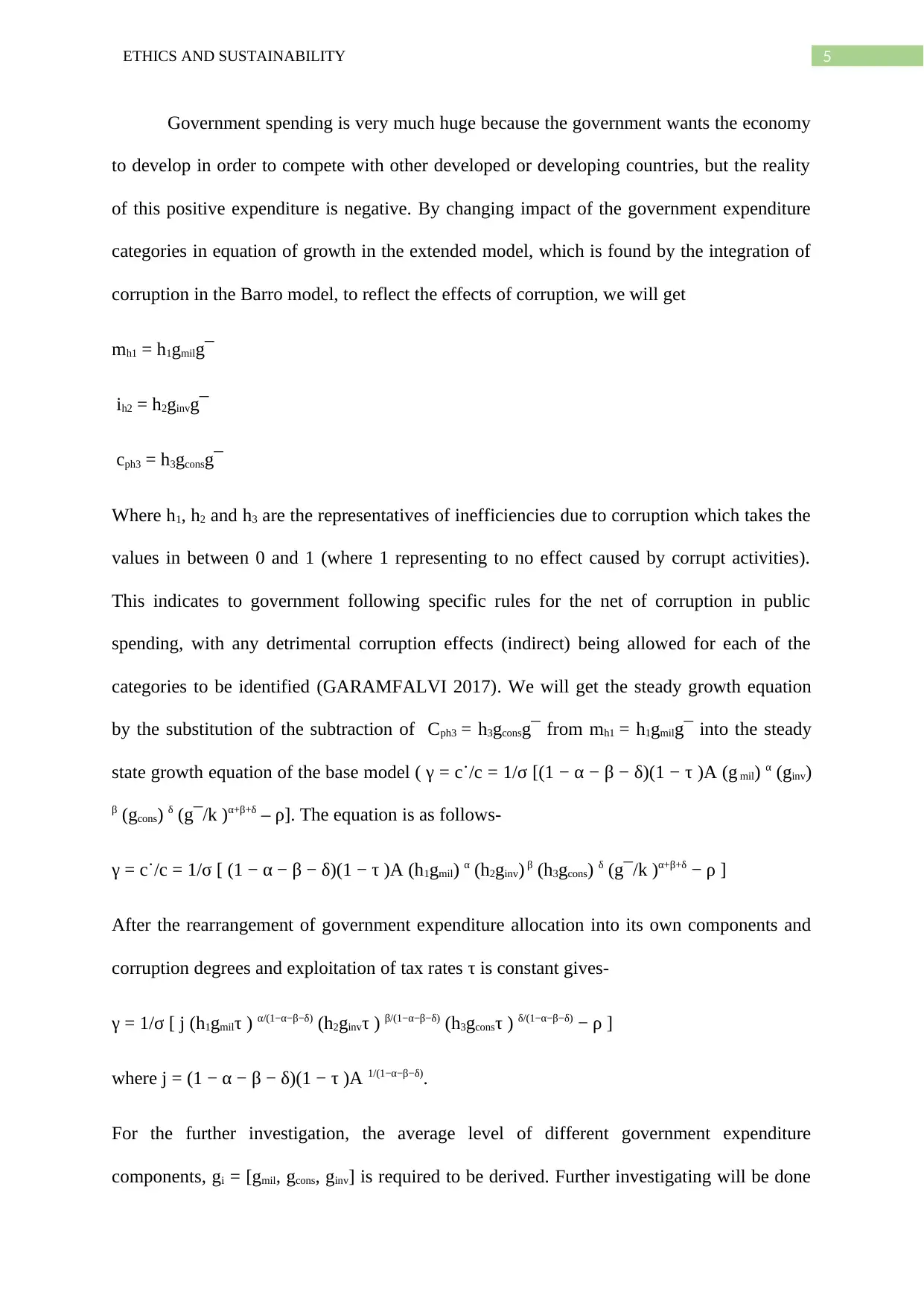
5ETHICS AND SUSTAINABILITY
Government spending is very much huge because the government wants the economy
to develop in order to compete with other developed or developing countries, but the reality
of this positive expenditure is negative. By changing impact of the government expenditure
categories in equation of growth in the extended model, which is found by the integration of
corruption in the Barro model, to reflect the effects of corruption, we will get
mh1 = h1gmilg¯
ih2 = h2ginvg¯
cph3 = h3gconsg¯
Where h1, h2 and h3 are the representatives of inefficiencies due to corruption which takes the
values in between 0 and 1 (where 1 representing to no effect caused by corrupt activities).
This indicates to government following specific rules for the net of corruption in public
spending, with any detrimental corruption effects (indirect) being allowed for each of the
categories to be identified (GARAMFALVI 2017). We will get the steady growth equation
by the substitution of the subtraction of Cph3 = h3gconsg¯ from mh1 = h1gmilg¯ into the steady
state growth equation of the base model ( γ = c˙/c = 1/σ [(1 − α − β − δ)(1 − τ )A (g mil) α (ginv)
β (gcons) δ (g¯/k )α+β+δ – ρ]. The equation is as follows-
γ = c˙/c = 1/σ [ (1 − α − β − δ)(1 − τ )A (h1gmil) α (h2ginv) β (h3gcons) δ (g¯/k )α+β+δ − ρ ]
After the rearrangement of government expenditure allocation into its own components and
corruption degrees and exploitation of tax rates τ is constant gives-
γ = 1/σ [ j (h1gmilτ ) α/(1−α−β−δ) (h2ginvτ ) β/(1−α−β−δ) (h3gconsτ ) δ/(1−α−β−δ) − ρ ]
where j = (1 − α − β − δ)(1 − τ )A 1/(1−α−β−δ).
For the further investigation, the average level of different government expenditure
components, gi = [gmil, gcons, ginv] is required to be derived. Further investigating will be done
Government spending is very much huge because the government wants the economy
to develop in order to compete with other developed or developing countries, but the reality
of this positive expenditure is negative. By changing impact of the government expenditure
categories in equation of growth in the extended model, which is found by the integration of
corruption in the Barro model, to reflect the effects of corruption, we will get
mh1 = h1gmilg¯
ih2 = h2ginvg¯
cph3 = h3gconsg¯
Where h1, h2 and h3 are the representatives of inefficiencies due to corruption which takes the
values in between 0 and 1 (where 1 representing to no effect caused by corrupt activities).
This indicates to government following specific rules for the net of corruption in public
spending, with any detrimental corruption effects (indirect) being allowed for each of the
categories to be identified (GARAMFALVI 2017). We will get the steady growth equation
by the substitution of the subtraction of Cph3 = h3gconsg¯ from mh1 = h1gmilg¯ into the steady
state growth equation of the base model ( γ = c˙/c = 1/σ [(1 − α − β − δ)(1 − τ )A (g mil) α (ginv)
β (gcons) δ (g¯/k )α+β+δ – ρ]. The equation is as follows-
γ = c˙/c = 1/σ [ (1 − α − β − δ)(1 − τ )A (h1gmil) α (h2ginv) β (h3gcons) δ (g¯/k )α+β+δ − ρ ]
After the rearrangement of government expenditure allocation into its own components and
corruption degrees and exploitation of tax rates τ is constant gives-
γ = 1/σ [ j (h1gmilτ ) α/(1−α−β−δ) (h2ginvτ ) β/(1−α−β−δ) (h3gconsτ ) δ/(1−α−β−δ) − ρ ]
where j = (1 − α − β − δ)(1 − τ )A 1/(1−α−β−δ).
For the further investigation, the average level of different government expenditure
components, gi = [gmil, gcons, ginv] is required to be derived. Further investigating will be done
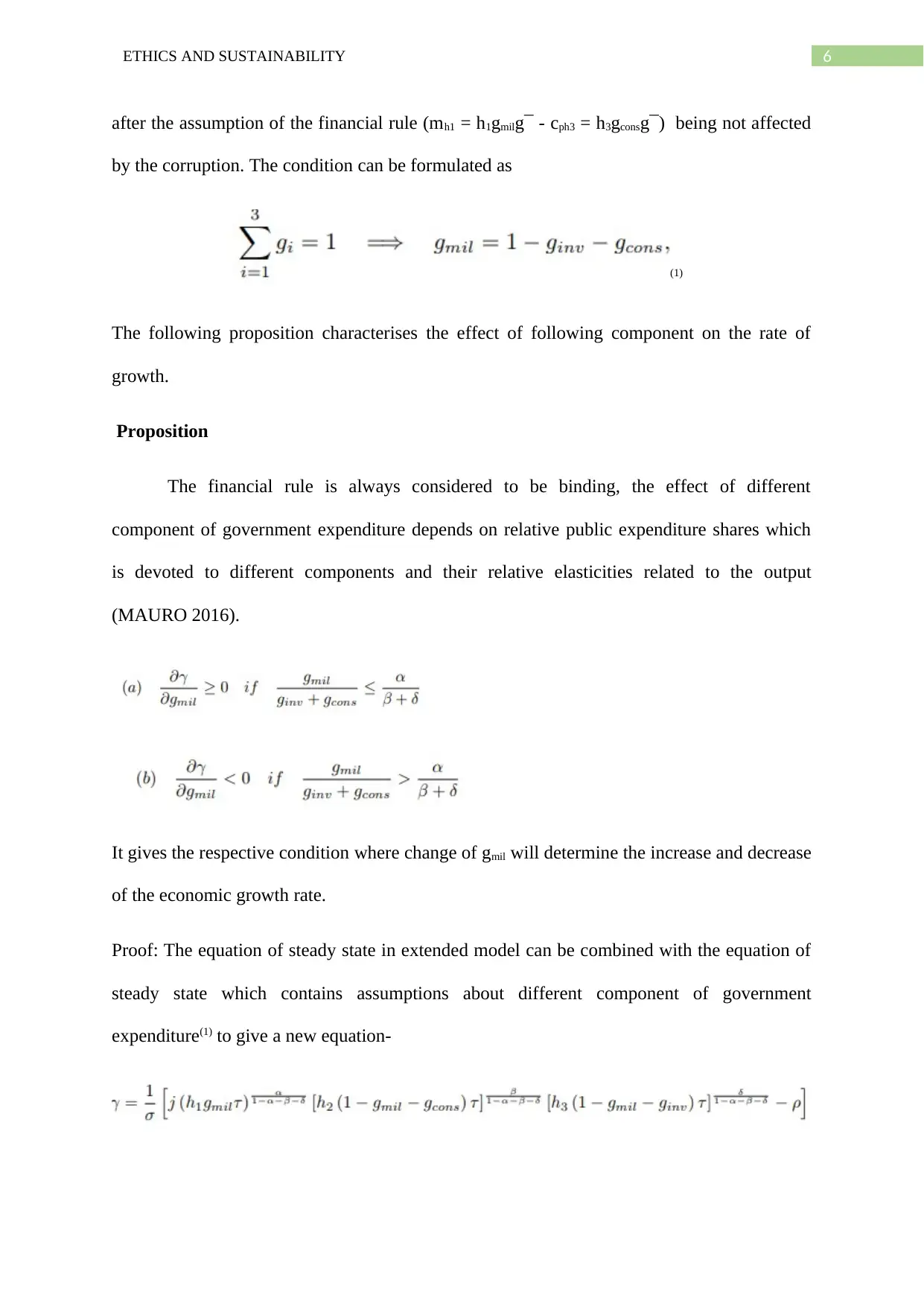
6ETHICS AND SUSTAINABILITY
after the assumption of the financial rule (mh1 = h1gmilg¯ - cph3 = h3gconsg¯) being not affected
by the corruption. The condition can be formulated as
(1)
The following proposition characterises the effect of following component on the rate of
growth.
Proposition
The financial rule is always considered to be binding, the effect of different
component of government expenditure depends on relative public expenditure shares which
is devoted to different components and their relative elasticities related to the output
(MAURO 2016).
It gives the respective condition where change of gmil will determine the increase and decrease
of the economic growth rate.
Proof: The equation of steady state in extended model can be combined with the equation of
steady state which contains assumptions about different component of government
expenditure(1) to give a new equation-
after the assumption of the financial rule (mh1 = h1gmilg¯ - cph3 = h3gconsg¯) being not affected
by the corruption. The condition can be formulated as
(1)
The following proposition characterises the effect of following component on the rate of
growth.
Proposition
The financial rule is always considered to be binding, the effect of different
component of government expenditure depends on relative public expenditure shares which
is devoted to different components and their relative elasticities related to the output
(MAURO 2016).
It gives the respective condition where change of gmil will determine the increase and decrease
of the economic growth rate.
Proof: The equation of steady state in extended model can be combined with the equation of
steady state which contains assumptions about different component of government
expenditure(1) to give a new equation-
⊘ This is a preview!⊘
Do you want full access?
Subscribe today to unlock all pages.

Trusted by 1+ million students worldwide
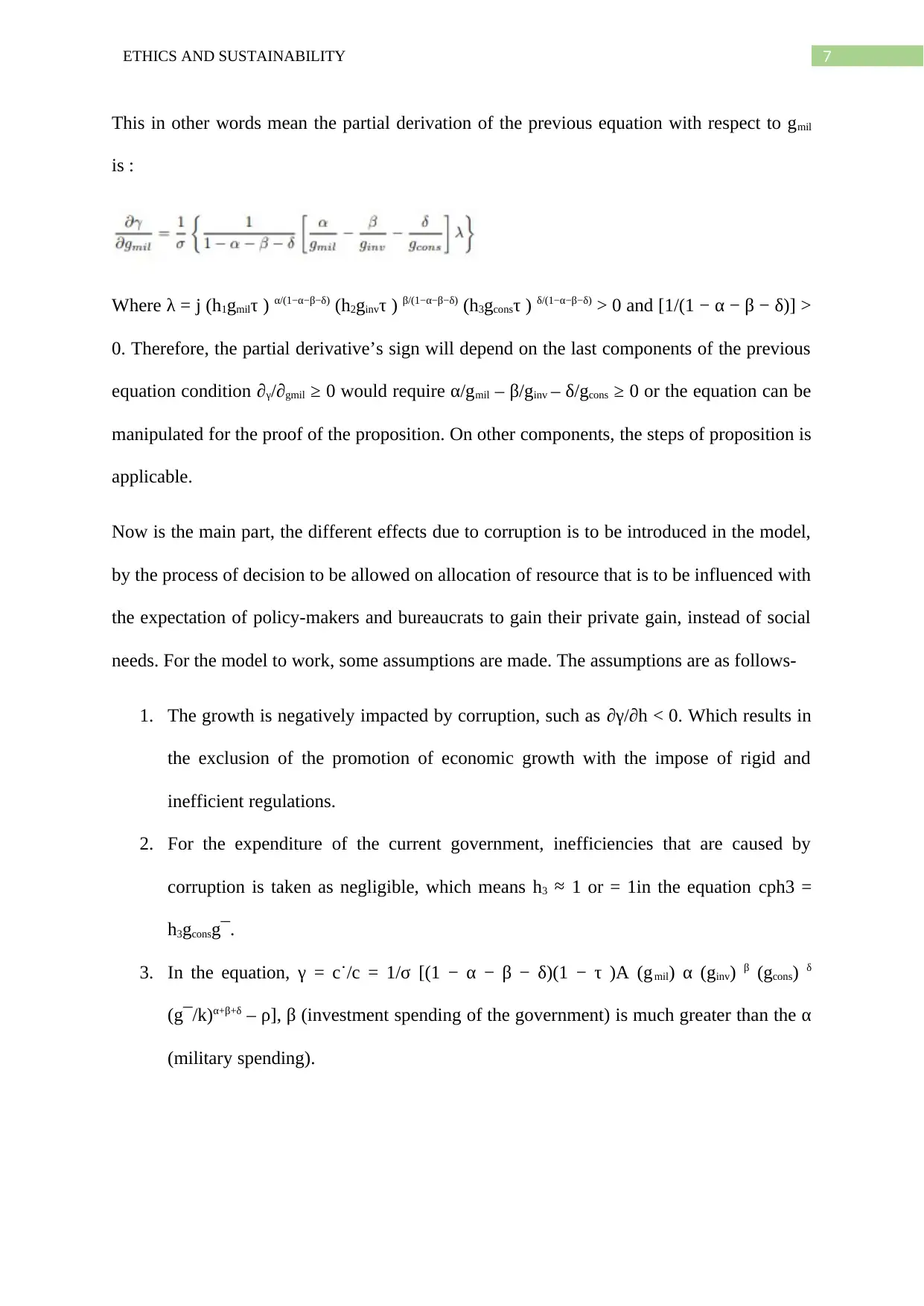
7ETHICS AND SUSTAINABILITY
This in other words mean the partial derivation of the previous equation with respect to gmil
is :
Where λ = j (h1gmilτ ) α/(1−α−β−δ) (h2ginvτ ) β/(1−α−β−δ) (h3gconsτ ) δ/(1−α−β−δ) > 0 and [1/(1 − α − β − δ)] >
0. Therefore, the partial derivative’s sign will depend on the last components of the previous
equation condition ∂γ/∂gmil ≥ 0 would require α/gmil – β/ginv – δ/gcons ≥ 0 or the equation can be
manipulated for the proof of the proposition. On other components, the steps of proposition is
applicable.
Now is the main part, the different effects due to corruption is to be introduced in the model,
by the process of decision to be allowed on allocation of resource that is to be influenced with
the expectation of policy-makers and bureaucrats to gain their private gain, instead of social
needs. For the model to work, some assumptions are made. The assumptions are as follows-
1. The growth is negatively impacted by corruption, such as ∂γ/∂h < 0. Which results in
the exclusion of the promotion of economic growth with the impose of rigid and
inefficient regulations.
2. For the expenditure of the current government, inefficiencies that are caused by
corruption is taken as negligible, which means h3 ≈ 1 or = 1in the equation cph3 =
h3gconsg¯.
3. In the equation, γ = c˙/c = 1/σ [(1 − α − β − δ)(1 − τ )A (gmil) α (ginv) β (gcons) δ
(g¯/k)α+β+δ – ρ], β (investment spending of the government) is much greater than the α
(military spending).
This in other words mean the partial derivation of the previous equation with respect to gmil
is :
Where λ = j (h1gmilτ ) α/(1−α−β−δ) (h2ginvτ ) β/(1−α−β−δ) (h3gconsτ ) δ/(1−α−β−δ) > 0 and [1/(1 − α − β − δ)] >
0. Therefore, the partial derivative’s sign will depend on the last components of the previous
equation condition ∂γ/∂gmil ≥ 0 would require α/gmil – β/ginv – δ/gcons ≥ 0 or the equation can be
manipulated for the proof of the proposition. On other components, the steps of proposition is
applicable.
Now is the main part, the different effects due to corruption is to be introduced in the model,
by the process of decision to be allowed on allocation of resource that is to be influenced with
the expectation of policy-makers and bureaucrats to gain their private gain, instead of social
needs. For the model to work, some assumptions are made. The assumptions are as follows-
1. The growth is negatively impacted by corruption, such as ∂γ/∂h < 0. Which results in
the exclusion of the promotion of economic growth with the impose of rigid and
inefficient regulations.
2. For the expenditure of the current government, inefficiencies that are caused by
corruption is taken as negligible, which means h3 ≈ 1 or = 1in the equation cph3 =
h3gconsg¯.
3. In the equation, γ = c˙/c = 1/σ [(1 − α − β − δ)(1 − τ )A (gmil) α (ginv) β (gcons) δ
(g¯/k)α+β+δ – ρ], β (investment spending of the government) is much greater than the α
(military spending).
Paraphrase This Document
Need a fresh take? Get an instant paraphrase of this document with our AI Paraphraser
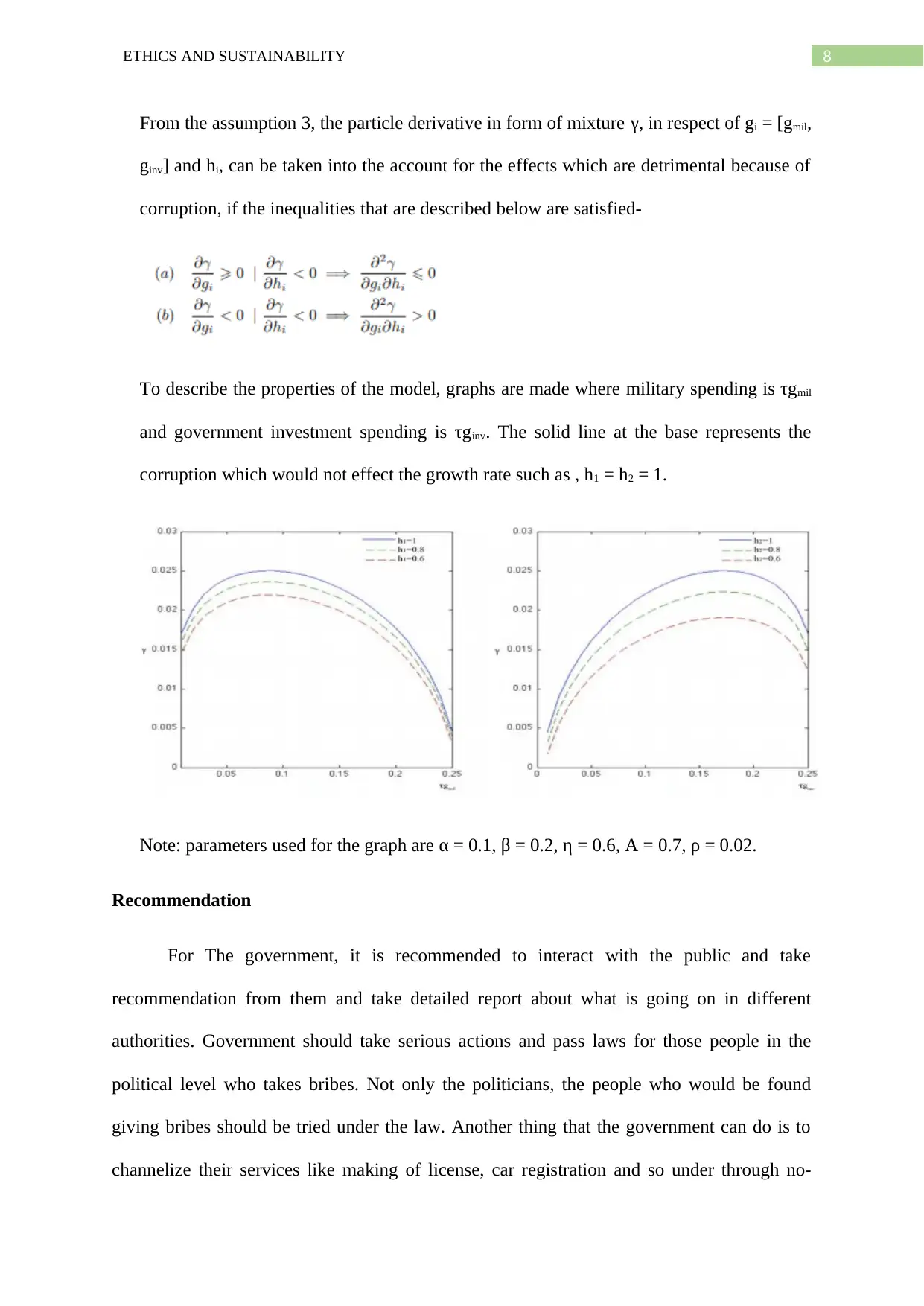
8ETHICS AND SUSTAINABILITY
From the assumption 3, the particle derivative in form of mixture γ, in respect of gi = [gmil,
ginv] and hi, can be taken into the account for the effects which are detrimental because of
corruption, if the inequalities that are described below are satisfied-
To describe the properties of the model, graphs are made where military spending is τgmil
and government investment spending is τginv. The solid line at the base represents the
corruption which would not effect the growth rate such as , h1 = h2 = 1.
Note: parameters used for the graph are α = 0.1, β = 0.2, η = 0.6, A = 0.7, ρ = 0.02.
Recommendation
For The government, it is recommended to interact with the public and take
recommendation from them and take detailed report about what is going on in different
authorities. Government should take serious actions and pass laws for those people in the
political level who takes bribes. Not only the politicians, the people who would be found
giving bribes should be tried under the law. Another thing that the government can do is to
channelize their services like making of license, car registration and so under through no-
From the assumption 3, the particle derivative in form of mixture γ, in respect of gi = [gmil,
ginv] and hi, can be taken into the account for the effects which are detrimental because of
corruption, if the inequalities that are described below are satisfied-
To describe the properties of the model, graphs are made where military spending is τgmil
and government investment spending is τginv. The solid line at the base represents the
corruption which would not effect the growth rate such as , h1 = h2 = 1.
Note: parameters used for the graph are α = 0.1, β = 0.2, η = 0.6, A = 0.7, ρ = 0.02.
Recommendation
For The government, it is recommended to interact with the public and take
recommendation from them and take detailed report about what is going on in different
authorities. Government should take serious actions and pass laws for those people in the
political level who takes bribes. Not only the politicians, the people who would be found
giving bribes should be tried under the law. Another thing that the government can do is to
channelize their services like making of license, car registration and so under through no-

9ETHICS AND SUSTAINABILITY
government organisations or make the use of digital services by the individuals to stop the
bribery. Another non-government authority should be taken in action to monitor the works,
activities and services of the government offices and officials and should report directly to the
prime minister or president of the country to take necessary action.
Conclusion
From the study of corruption, it came into observation that, small bribery provided by
us for our work to be done is resulting in the declination of our economy. Not only the
corruption is effecting our economy directly but there are many indirect causes that are
harming very much to our economy. The government’s huge expenditure of the defence,
culture, education, public health and so on, which is spent by government with a positive
though to develop the economy ends up as black money under the grips of some politicians
resulting in the declination of the economy.
government organisations or make the use of digital services by the individuals to stop the
bribery. Another non-government authority should be taken in action to monitor the works,
activities and services of the government offices and officials and should report directly to the
prime minister or president of the country to take necessary action.
Conclusion
From the study of corruption, it came into observation that, small bribery provided by
us for our work to be done is resulting in the declination of our economy. Not only the
corruption is effecting our economy directly but there are many indirect causes that are
harming very much to our economy. The government’s huge expenditure of the defence,
culture, education, public health and so on, which is spent by government with a positive
though to develop the economy ends up as black money under the grips of some politicians
resulting in the declination of the economy.
⊘ This is a preview!⊘
Do you want full access?
Subscribe today to unlock all pages.

Trusted by 1+ million students worldwide
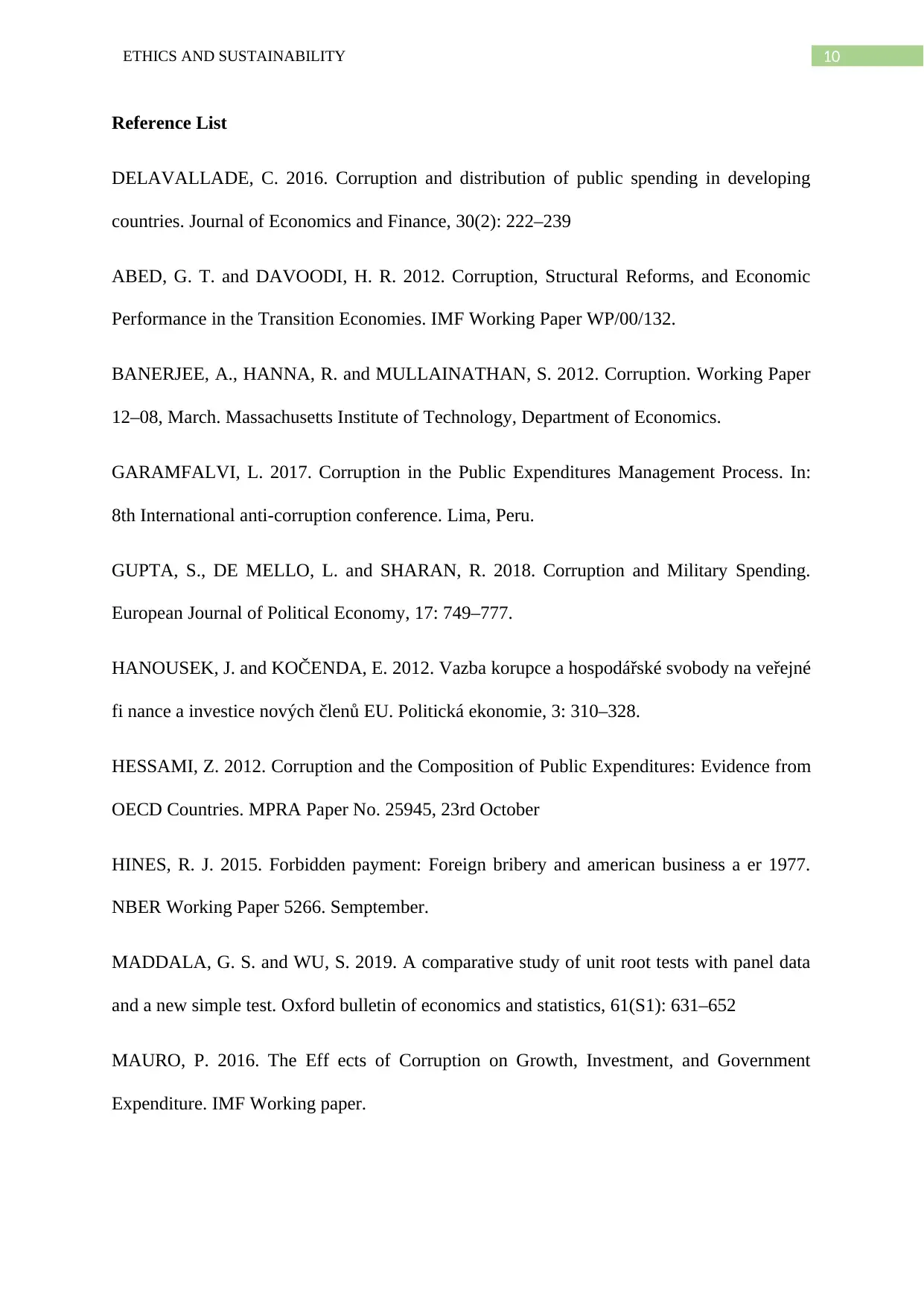
10ETHICS AND SUSTAINABILITY
Reference List
DELAVALLADE, C. 2016. Corruption and distribution of public spending in developing
countries. Journal of Economics and Finance, 30(2): 222–239
ABED, G. T. and DAVOODI, H. R. 2012. Corruption, Structural Reforms, and Economic
Performance in the Transition Economies. IMF Working Paper WP/00/132.
BANERJEE, A., HANNA, R. and MULLAINATHAN, S. 2012. Corruption. Working Paper
12–08, March. Massachusetts Institute of Technology, Department of Economics.
GARAMFALVI, L. 2017. Corruption in the Public Expenditures Management Process. In:
8th International anti-corruption conference. Lima, Peru.
GUPTA, S., DE MELLO, L. and SHARAN, R. 2018. Corruption and Military Spending.
European Journal of Political Economy, 17: 749–777.
HANOUSEK, J. and KOČENDA, E. 2012. Vazba korupce a hospodářské svobody na veřejné
fi nance a investice nových členů EU. Politická ekonomie, 3: 310–328.
HESSAMI, Z. 2012. Corruption and the Composition of Public Expenditures: Evidence from
OECD Countries. MPRA Paper No. 25945, 23rd October
HINES, R. J. 2015. Forbidden payment: Foreign bribery and american business a er 1977.
NBER Working Paper 5266. Semptember.
MADDALA, G. S. and WU, S. 2019. A comparative study of unit root tests with panel data
and a new simple test. Oxford bulletin of economics and statistics, 61(S1): 631–652
MAURO, P. 2016. The Eff ects of Corruption on Growth, Investment, and Government
Expenditure. IMF Working paper.
Reference List
DELAVALLADE, C. 2016. Corruption and distribution of public spending in developing
countries. Journal of Economics and Finance, 30(2): 222–239
ABED, G. T. and DAVOODI, H. R. 2012. Corruption, Structural Reforms, and Economic
Performance in the Transition Economies. IMF Working Paper WP/00/132.
BANERJEE, A., HANNA, R. and MULLAINATHAN, S. 2012. Corruption. Working Paper
12–08, March. Massachusetts Institute of Technology, Department of Economics.
GARAMFALVI, L. 2017. Corruption in the Public Expenditures Management Process. In:
8th International anti-corruption conference. Lima, Peru.
GUPTA, S., DE MELLO, L. and SHARAN, R. 2018. Corruption and Military Spending.
European Journal of Political Economy, 17: 749–777.
HANOUSEK, J. and KOČENDA, E. 2012. Vazba korupce a hospodářské svobody na veřejné
fi nance a investice nových členů EU. Politická ekonomie, 3: 310–328.
HESSAMI, Z. 2012. Corruption and the Composition of Public Expenditures: Evidence from
OECD Countries. MPRA Paper No. 25945, 23rd October
HINES, R. J. 2015. Forbidden payment: Foreign bribery and american business a er 1977.
NBER Working Paper 5266. Semptember.
MADDALA, G. S. and WU, S. 2019. A comparative study of unit root tests with panel data
and a new simple test. Oxford bulletin of economics and statistics, 61(S1): 631–652
MAURO, P. 2016. The Eff ects of Corruption on Growth, Investment, and Government
Expenditure. IMF Working paper.
Paraphrase This Document
Need a fresh take? Get an instant paraphrase of this document with our AI Paraphraser
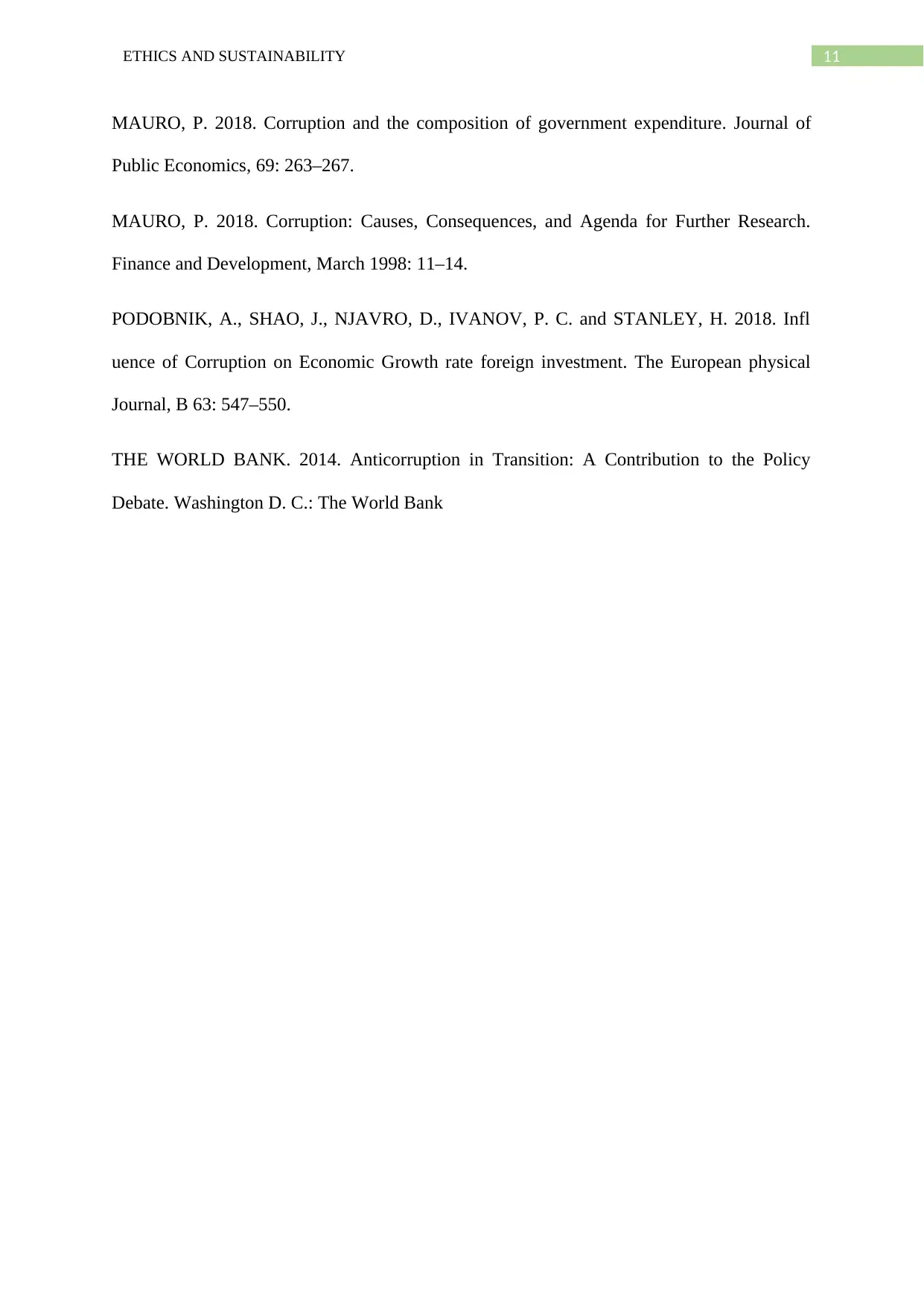
11ETHICS AND SUSTAINABILITY
MAURO, P. 2018. Corruption and the composition of government expenditure. Journal of
Public Economics, 69: 263–267.
MAURO, P. 2018. Corruption: Causes, Consequences, and Agenda for Further Research.
Finance and Development, March 1998: 11–14.
PODOBNIK, A., SHAO, J., NJAVRO, D., IVANOV, P. C. and STANLEY, H. 2018. Infl
uence of Corruption on Economic Growth rate foreign investment. The European physical
Journal, B 63: 547–550.
THE WORLD BANK. 2014. Anticorruption in Transition: A Contribution to the Policy
Debate. Washington D. C.: The World Bank
MAURO, P. 2018. Corruption and the composition of government expenditure. Journal of
Public Economics, 69: 263–267.
MAURO, P. 2018. Corruption: Causes, Consequences, and Agenda for Further Research.
Finance and Development, March 1998: 11–14.
PODOBNIK, A., SHAO, J., NJAVRO, D., IVANOV, P. C. and STANLEY, H. 2018. Infl
uence of Corruption on Economic Growth rate foreign investment. The European physical
Journal, B 63: 547–550.
THE WORLD BANK. 2014. Anticorruption in Transition: A Contribution to the Policy
Debate. Washington D. C.: The World Bank
1 out of 11
Your All-in-One AI-Powered Toolkit for Academic Success.
+13062052269
info@desklib.com
Available 24*7 on WhatsApp / Email
![[object Object]](/_next/static/media/star-bottom.7253800d.svg)
Unlock your academic potential
Copyright © 2020–2025 A2Z Services. All Rights Reserved. Developed and managed by ZUCOL.
